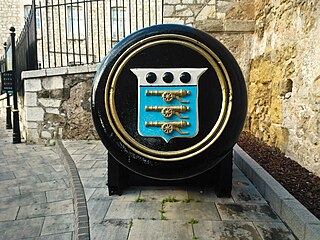Henry Adrian "Packy" Schade was a United States Navy officer, naval architect, and professor.

The Board of Ordnance was a British government body. Established in the Tudor period, it had its headquarters in the Tower of London. Its primary responsibilities were 'to act as custodian of the lands, depots and forts required for the defence of the realm and its overseas possessions, and as the supplier of munitions and equipment to both the Army and the Navy'. The Board also maintained and directed the Artillery and Engineer corps, which it founded in the 18th century. By the 19th century, the Board of Ordnance was second in size only to HM Treasury among government departments. The Board lasted until 1855, at which point it was disbanded.
A midshipman is an officer of the lowest rank in the Royal Navy, United States Navy, and many Commonwealth navies. Commonwealth countries which use the rank include Canada, Australia, Bangladesh, Namibia, New Zealand, South Africa, India, Pakistan, Singapore, Sri Lanka, and Kenya.

Woolwich Dockyard was an English naval dockyard along the river Thames at Woolwich - originally in north-west Kent, now in southeast London - where many ships were built from the early 16th century until the late 19th century. William Camden called it 'the Mother Dock of all England'. By virtue of the size and quantity of vessels built there, Woolwich Dockyard is described as having been 'among the most important shipyards of seventeenth-century Europe'. During the Age of Sail, the yard continued to be used for shipbuilding and repair work more or less consistently; in the 1830s a specialist factory within the dockyard oversaw the introduction of steam power for ships of the Royal Navy. At its largest extent it filled a 56-acre site north of Woolwich Church Street, between Warspite Road and New Ferry Approach; 19th-century naval vessels were fast outgrowing the yard, however, and it eventually closed in 1869. The former dockyard area is now partly residential, partly industrial, with remnants of its historic past having been restored.
In the United States Navy, officers have various ranks. Equivalency between services is by pay grade. United States Navy commissioned officer ranks have two distinct sets of rank insignia: On dress uniform a series of stripes similar to Commonwealth naval ranks are worn; on service khaki, working uniforms, and special uniform situations, the rank insignia are identical to the equivalent rank in the US Marine Corps.

The Italian Navy is one of the four branches of Italian Armed Forces and was formed in 1946 from what remained of the Regia Marina after World War II. As of August 2014, the Italian Navy had a strength of 30,923 active personnel, with approximately 184 vessels in service, including minor auxiliary vessels. It is considered a multiregional and a blue-water navy.

The Israeli Navy is the naval warfare service arm of the Israel Defense Forces, operating primarily in the Mediterranean Sea theater as well as the Gulf of Eilat and the Red Sea theater. The current commander in chief of the Israeli Navy is Aluf David Saar Salama. The Israeli Navy is believed to be responsible for maintaining Israel's offshore nuclear second strike capability.

Benjamin Franklin Isherwood was an engineering officer in the United States Navy during the early days of steam-powered warships. He served as a ship's engineer during the Mexican–American War, and after the war did experimental work with steam propulsion. Rising to the rank of rear admiral, as Engineer-in-Chief of the Navy during the Civil War, he helped to found the Navy's Bureau of Steam Engineering.

The Picatinny Arsenal is an American military research and manufacturing facility located on 6,400 acres (26 km2) of land in Jefferson and Rockaway Township in Morris County, New Jersey, United States, encompassing Picatinny Lake and Lake Denmark. The Arsenal is the headquarters of the US Army Combat Capabilities Development Command Armaments Center. It is known for developing the ubiquitous Picatinny rail, as well as being the Army's center of expertise for small arms cartridge ammunition.

The Royal Army Ordnance Corps (RAOC) was a corps of the British Army. At its renaming as a Royal Corps in 1918 it was both a supply and repair corps. In the supply area it had responsibility for weapons, armoured vehicles and other military equipment, ammunition and clothing and certain minor functions such as laundry, mobile baths and photography. The RAOC was also responsible for a major element of the repair of Army equipment. In 1942 the latter function was transferred to the Royal Electrical and Mechanical Engineers (REME) and the vehicle storage and spares responsibilities of the Royal Army Service Corps were in turn passed over to the RAOC. The RAOC retained repair responsibilities for ammunition, clothing and certain ranges of general stores. In 1964 the McLeod Reorganisation of Army Logistics resulted in the RAOC absorbing petroleum, rations and accommodation stores functions from the Royal Army Service Corps as well as the Army Fire Service, barrack services, sponsorship of NAAFI (EFI) and the management of staff clerks from the same Corps. On 5 April 1993, the RAOC was one of the corps that amalgamated to form The Royal Logistic Corps (RLC).
Seafaring is a tradition that encompasses a variety of professions and ranks. Each of these roles carries unique responsibilities that are integral to the successful operation of a seafaring vessel. A ship's crew can generally be divided into four main categories: the deck department, the engineering department, the steward's department, and other. The reasoning behind this is that a ship's bridge, filled with sophisticated navigational equipment, requires skills differing from those used on deck operations – such as berthing, cargo and/or military devices – which in turn requires skills different from those used in a ship's engine room and propulsion, and so on.

Nikola Vaptsarov Naval Academy (NVNA) is the oldest technical educational institution in the Republic of Bulgaria. Its history, past and present achievements establish the institution as the most prestigious centre for training maritime specialists in the country. Its development over the years resembles a navigable river, into which many tributaries flow, as well as the "prototypes" of the present-day faculties, departments, and vocational colleges constituting the Nikola Vaptsarov Naval Academy.
In the uniformed services of the United States, captain is a commissioned-officer rank. In keeping with the traditions of the militaries of most nations, the rank varies between the services, being a senior rank in the naval services and a junior rank in the ground and air forces. Many fire departments and police departments in the United States also use the rank of captain as an officer in a specific unit.
The Naval Facilities Engineering Systems Command (NAVFAC) is the United States Navy's engineering systems command, providing the Navy and United States Marine Corps with facilities and expeditionary expertise. NAVFAC is headquartered at the Washington Navy Yard and is under the command of the Chief of Civil Engineers RADM Dean VanderLey
The Bureau of Steam Engineering was a bureau of the United States Navy, created by the act of 5 July 1862, receiving some of the duties of the former Bureau of Construction, Equipment and Repair. It became, by the Naval Appropriation Act of 4 June 1920, the Bureau of Engineering (BuEng). In 1940 it combined with the Bureau of Construction and Repair (BuC&R) and became the Bureau of Ships (BuShips).

Vice Admiral Baron Yuzuru Hiraga was a career naval officer in the Imperial Japanese Navy, Doctor of Engineering and head of the engineering school of Tokyo Imperial University and a leading Japanese naval architect in the 1910s and 1920s, responsible for designing a number of famous warships, many of which would later see action during World War II. He participated in establishing the Chiba Institute of Technology from 1941.

Admiral Samuel Murray Robinson was a United States Navy four-star admiral who directed Navy procurement during World War II.
A logistics officer is a member of an armed force or coast guard responsible for overseeing the support of an army, air force, marine corps, navy or coast guard fleet, both at home and abroad. Logistics officers can be stationary on military bases or deployed as an active part of a field army, air wing, naval force or coast guard fleet. The responsibilities of Logistics Officers vary, depending on where they are deployed and what tasks they are assigned. In addition, different countries have different roles for Logistics Officers. The main role of these officers remains the same regardless of where they are stationed; to ensure that the force is supplied with enough food, water, fuel, ammunition and other goods and services to complete the task at hand.

The U.S. Army acquired ten ships during World War II as Engineer Port Repair Ships, also sometimes known as Port Rehabilitation ships, for use by the U.S. Army Corps of Engineers to clear war damaged harbors. The need was anticipated by 1942 for the post invasion recovery of ports in Europe and the Transportation Corps was assigned the responsibility to acquire and modify the ships that would be military crewed under the Corps of Engineers.
The following is the structure of the Italian Navy as of June 2020. It is considered a multiregional and a blue-water navy.












